|
|
|
| APOLLO 4 spurs lunar landing program | |
|
The earth trembled and spectators' eardrums were battered with the loudest non-nuclear noise ever produced by man. Belching flame and smoke, the 36-story tall space vehicle blistered the launch pad with 7.5 million pounds of thrust. The vehicle inched upward, agonizingly slow. Gradually it picked up speed, finally clearing the mobile launcher. Higher and higher it rose at ever increasing speed until it was just a flaming speck in the sky. Finally, after a puff of smoke signaled the ignition of the second stage, the speck vanished. This was the first flight of the monstrous Saturn-V/Apollo stack, the same awesome combination that will rocket three American astronauts on a round trip to the moon. The unmanned vehicles lifted off from the Kennedy Space Center in Florida on November 9, 1967, at 6:00:01.4 a.m. CST. Eight hours and 36.54 seconds later, the Apollo spacecraft atop the rocket at liftoff, now hideously scorched from the searing re-entry, splashed down in the North Pacific some 540 nautical miles northwest of Hawaii. The splashdown and the events leading up to it marked a giant stride in America's manned lunar journey. |
|
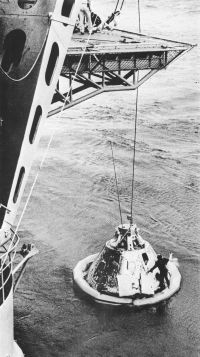 Recovery ship Bennington prepares to hoist aboard scorched command module. |
The mission, designated Apollo 4, included several significant milestones in the U.S. lunar landing program: • It was the first launch from the Kennedy Space Center Launch Complex 39, built around a mobile concept. (Under this concept, the space vehicle is thoroughly checked in an enclosed building before it is moved to the launch pad for final preparations. This affords greater protection from the weather, a more systematic checkout process, and a higher launch rate because pad time is minimal.) The launch vehicle placed the Apollo spacecraft and the third (S-IVB) stage into a 102.5 nautical mile orbit. After completing two orbits, the third stage re-ignited to place the Apollo spacecraft into orbit with an apogee of 9,391 nautical miles (10,800 statute miles). Upon separating from the third stage, the spacecraft raised its apogee to 9,769 nautical miles by firing its service propulsion system (SPS) engine. A second SPS burn during descent from apogee boosted re-entry velocity to more than 36,333 feet-per-second (21,800 knots) for the command module. The command module, protected by its heat shield, re-entered the atmosphere. The command module's lift capability was used to split re-entry heating into two pulses. Drogue and main parachutes functioned normally and the spacecraft at splashdown was sighted from the deck of the prime recovery vessel, USS Bennington. The landing point was some 18,500 yards west of the aiming point. |
|
The Saturn first stage (V S-IC) and second stage (S-II) performed as planned on their maiden flight. The third stage (S-IVB) had flown four times earlier as the second stage of the Uprated Saturn-I. Commenting on Apollo 4 mission results at a post-flight press conference, NASA Deputy Administrator Dr. Robert C. Seamans said, "Today we placed in earth orbit over 280,000 pounds. To give this some perspective, this is three times the weight of the six manned Mercury spacecraft and the ten manned Gemini spacecraft that we have flown." |
|
|
"And I believe," Seamans continued, "that this is a clear indication that our team of government, industry and university people was not found wanting, and that we do have the capacity in this country to be preeminent not only in space, but in all human endeavor involving science and technology. The power of the Saturn-V is exceeded many-fold by our power in this country to accomplish the near impossible for the good of all mankind." The hellish heat generated at blastoff put a piece of Collins equipment to its most diabolical test. The equipment, a RADlC (from RAdio interior Communication) station, was located only 30 feet from the thundering rocket. When the launch area cooled down enough for NASA personnel to inspect the effects of liftoff, they found the RADlC station torn from its mount, hanging by its coaxial cable and the tubing used to purge the unit with inert gas. All the control knobs were melted and the circuit cards were vibrated loose: But when the NASA personnel re-seated the cards, the station played as well as any of its some 2,000 counterparts at Launch Complex 39. These RADIC stations are used by NASA personnel for communication during assembly, checkout and launch operations. |
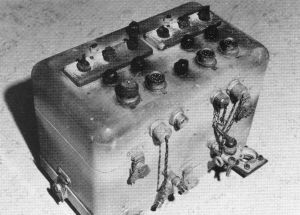 This RADIC station, only 30 feet from Apollo 4 at blastoff, withstood tremendous heat and vibration; yet it still played. |
|
The success of Apollo 4 has rekindled America's hope of rocketing astronauts to the moon and back by the end of this decade. Recently NASA announced a new schedule for reaching this goal. In the revised Apollo schedule, command, service and lunar modules will be tested and qualified on concurrent unmanned flights of the uprated Saturn and Saturn-V launch vehicles. (Apollo/uprated Saturn flights are identified with a two-hundred series number, i.e.,Apollo/Saturn 204. Saturn-V flights are identified with a five-hundred series number, i.e., Apollo/Saturn 502.) The schedule for 1968: These flights will be flown in the above order and as rapidly as all necessary preparations can be completed. As they proceed, all opportunities to accelerate progress toward manned flights and a rapid accumulation of manned experience with the Apollo/Saturn system will be sought. The 1969 Apollo flight schedule calls for five manned Apollo/Saturn flights (A/s 505 through A/s 509). Four of these flights, A/s 505 through 508, are programmed as lunar mission development flights or simulations. It is possible that the lunar landing could be made on the Apollo/Saturn 509, but it is also possible that the landing may be delayed until one of the remaining six Saturn-V flights. |
|
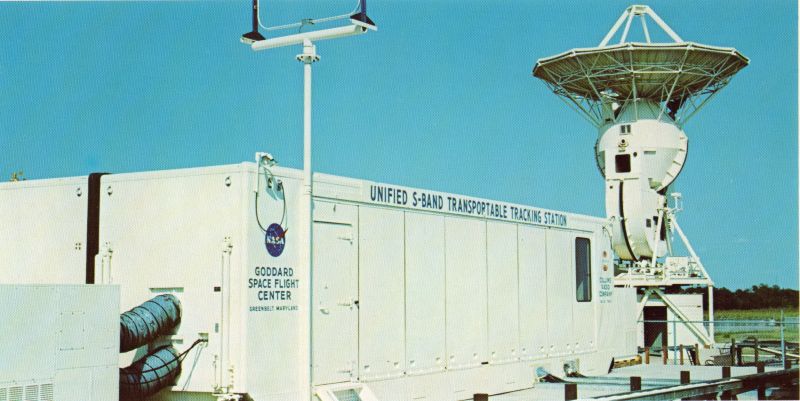 This transportable unified S-band tracking and communication station is being used in the lunar landing program. Station is one of 15 built by Collins for NASA's Goodard Space Flight Center, which is responsible for the worldwide Manned Space Flight Network. |
|
|
Unified S-band spacecraft communication equipment and ground tracking/communication systems provided by Collins performed significant roles in the highly successful Apollo 4 test flight. The unmanned command module system performed these functions: Two-way telemetry transmission. Receiving and automatic retransmission of ranging signals to determine orbital velocity and position of the spacecraft. Recovery communication. This was the third space flight test of the spacecraft communication system, it having been used on two previous unmanned Apollo test flights. In future manned flights, the system will provide two-way voice communication for astronauts and television transmission from spacecraft to earth. The new unified S-Band ground tracking/communication network, for which Collins is prime contractor, was tested for the first time with an Apollo spacecraft during the Apollo 4 mission. This network includes 12 stations with 30-foot antennas and three stations with 85-foot antennas. Eleven of the 30-foot stations and one of the 85-foot stations were used for communication with and tracking the spacecraft. Also employed during the mission was the tracking ship Vanguard, which has Collins systems aboard. Eventually the new use ground network will be used for all tracking, communication and data acquisition on all Apollo missions, including the flight to land astronauts on the moon and return them safely to earth. The spacecraft communication and data system is provided by Collins under contract to North American Rockwell Corp., and the use ground network system is provided under contract to NASA's Goddard Space Flight Center. Both the spacecraft and ground systems will be used throughout Project Apollo. |
|
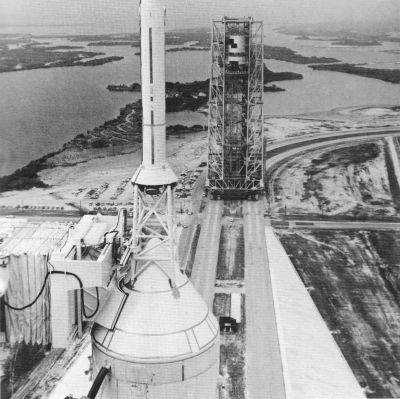 View from atop Apollo 4 before launch from Kennedy Space Center shows approaching mobile service structure, which is used to ready launch vehicle and spacecraft for flight. |
USB combines near-earth and deep-space communication requirements in a single band of radio frequencies. The communication and data system also employs VHF for near-earth and command module-to-lunar module communications. For recover operations, VHF and HF provide the communication link. use replaces C-Band, used in Mercury and Gemini, for ranging; although continued use of C-Band is programmed along with use in initial Apollo flights. Design of the use system was based on the coherent doppler and pseudo-random range technique, developed by NASA's Jet Propulsion Laboratory, and used in previous unmanned deep space probes. This technique involves a ground-based transmitting and receiving station, working in conjunction with a spacecraft transponder. A single carrier frequency is utilized in each direction for the transmission of all tracking and communications data between the spacecraft and ground. The voice and up-date data are modulated onto subcarriers and then combined with the ranging data. This composite information is used to phase-modulate the transmitted carrier frequency. The received and transmitted carrier frequencies are coherently related, This allows measurements of the carrier doppler frequency by the ground station for precise determination of the radial velocity of the spacecraft. Voice and telemetry data from the spacecraft are modulated onto subcarriers, combined with the ranging signals, and used to phase modulate the down-link carrier frequency. The spacecraft S-Band transponder transmitter also can be frequency modulated for transmitting television, analog data, or recorded voice and data. The ground-command module up-link frequency in the phase-modulation mode is 2106.4 MHz. The coherently related down-link command module earth frequency in the phase-modulation mode is 2287.5 MHz. A second down-link frequency, 2272.5 MHz, operates in the FM mode. |
|
Simultaneous transmissions can be made on all three S-Band frequencies. In the frequency modulation mode, however, television by itself can be transmitted or analog data/recorded voice and data can be sent, but not simultaneously. The communication and data system is actually a subsystem of the command module, provided by North American Rockwell to NASA. As communication and data subsystem manager, Collins was responsible not only for the system engineering, system testing, and management of the program but also for the design and manufacture of certain of the equipments. They include: Audio center - A solid-state audio amplification and control unit providing a complete and independently operated audio station for each astronaut. Furnishes each crew member with microphone and earphone amplifiers, diode switching circuits that control audio signals to and from operating RF equipment or an intercom system, and vox circuitry to permit voice keying of transmitters. Three electrically identical groups of audio and switching circuitry are contained in 31 small, encapsulated cordwood assemblies, housed in a gasket-sealed aluminum case. S-band power amplifier - A traveling-wave-tube power amplifier for high power amplification of the low-level outputs of transponder. The PA unit contains two independent power amplifiers, either of which can be used to amplify either the PM or FM frequency mode. Two power levels, approximately 2.5 and I I watts, are provided. The power amplifier is packaged in a sealed pressurized case, about 5.75 inch wide, 6 inches high and 22 inches long. The PA weighs 32 pounds. | 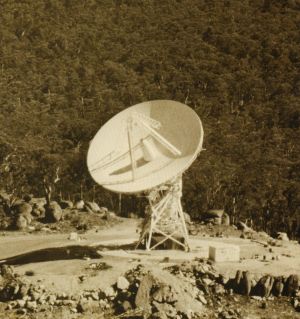 Eighty-five-foot antenna belongs to the unified S-band station at Canberra, Australia. |
|
Pre-modulation processor - It provides the signal multiplexing and interfacing between voice, data, television and recording equipment, and command module RF transmitting and receiving equipment. When the premodulation processor is used in conjunction with the transponder, both perform many communication functions that otherwise would require separate transmitters and receivers. The pre-modulation processor functions for all S-band transmission and reception except the ranging signal and provides interfacing with USB for command module-lunar module communication via VHF/AM. The pre-modulation processor is of solid-state design with redundant circuitry and modular construction. Weight is I 1.3 pounds. The unit is approximately 4.7 inches wide, 6 inches high and 10.5 inches long. HF transceiver - Employed for long-range direction finding and voice communication during landing and recovery phases of mission. Operable in single sideband, compatible AM or cw modes on preassigned carrier frequency of 10.006 MHz. Power output is 20 watts PEP in SSB, and 5 watts carrier in AM and cw. Transceiver is enclosed in a machined aluminum case, 4 inches wide, 6 inches high and 8.5 inches long. Weight is 6.3 pounds. VHF recovery beacon - A solid-state tone-modulated AM transmitter that provides signal for line-of-sight radio direction finding during landing and recovery operations. Recovery beacon transmits with 3-watt minimum power at 243 MHz. It has an automatic transmission interruption cycle of 2 seconds on and 3 seconds off. Unit consists of a modulator-regulator assembly and an RF amplifier-oscillator assembly. Weight is 2.5 pounds, and dimensions are 4 inches wide, 4 inches high and 6.75 inches long. |
|
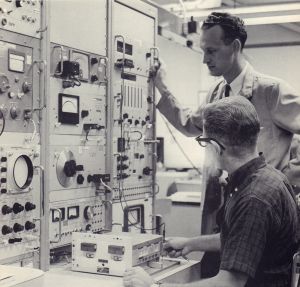 Collins test technician and supervisor conduct bench test of Apollo command module communications and data system equipment. |
Other elements of the spacecraft communication and data system are a VHF AM transmitter-receiver for near-earth and recovery communication, unified S-band equipment (two phase-locked transponders and an FM transmitter), PCM telemetry equipment, data storage equipment, and a VHF triplexer for simultaneous operation of three channels on a single antenna. The normal spacecraft-earth voice communication channel is via USB. Voice and telemetry signals originating in the spacecraft modulate a subcarrier in the pre-modulation processor. The subcarrier is routed to the unified S-band equipment, where it modulates one of the two redundant transponder transmitters. The output of the S-band equipment may be routed directly to the S-band antenna system or first passed through the S-band power amplifier, where it is amplified to one of two selectable power levels. The communications and tracking for Apollo is provided by elements of the Manned Space Flight Network, built for Mercury, augmented for Gemini and further expanded to meet the unique requirements of Apollo. The present Manned Space Flight Network, managed for NASA by Goddard Space Flight Center, involves not only NASA, but also elements of the Department of Defense and several foreign countries. Several of the stations, including instrumentation ships, are operated by the DOD. Stations in Australia are operated by Australians under participating agreements with the Australian government. The Manned Space Flight Network may be regarded as a real-time, global extension of the monitoring and control capabilities of the Manned Space Flight Control Center in Houston. In order to accomplish this extension, it is necessary to have an effective world-wide communications network. The communications network, in fact, becomes one of the most important items in the support of the mission. |
| —Collins Signal, Issue 66, Volume 16-1, 1968 - Pages 16-23 | |